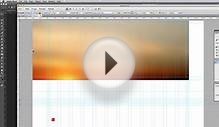
 '08
'08
Archived under,
Want to know how to design? Then you should learn the basics of design. The basic elements of design include colour, line, shape, scale, space, texture and value and these are the fundamental pieces that make up any piece of work. If you ever start a design course this will be the very first thing that you are taught, guaranteed.
But what if you’re not a student? What if you’re not self-taught? What if you are a looking for ways to enhance your design skills? Then this is the guide for you.
Note from Jacob Cass: This is a guest article written by Lauren Marie who is a graphic designer in corporate America during the day and a blogger via night.
Colour
 Colour has a huge impact on the mood of the design. A predominantly red colour usually represents strong emotions—love, anger, passion—while blue can make the design feel calm, cool and peaceful. Color contributes to the unity of a series of flyers, emphasizes important information and leads the eye through a design.
Colour has a huge impact on the mood of the design. A predominantly red colour usually represents strong emotions—love, anger, passion—while blue can make the design feel calm, cool and peaceful. Color contributes to the unity of a series of flyers, emphasizes important information and leads the eye through a design.
Select articles on color:
Line
Are your lines straight and slim, or thick and squiggly? The quality of the line (hand drawn to precise) can say a lot about the mood you are setting with your design. Hand drawn or thick lines tend towards juvenile themes, where as straight and thin lines are more refined, corporate or intelligent.
How lines interact with each other is important, too. If they are straight, thin lines, but are colliding at all sorts of crazy angles, that is going to be chaotic. If they have a hand drawn quality to them but are more or less straight and orderly, this can give a much needed personal appeal to a design.
Select articles on line:
Shape

Did you know that shapes can convey a mood just like any other element of design? Angular shapes like squares and triangles tend to indicate masculinity, while smooth and curving shapes like circles are more feminine. Squares are very familiar to us (think of your monitor, a piece of paper or the TV screen), so they are secure, trustworthy and stable. Circles very pleasing to the eye and are organic, whole, peaceful and exude unity.
Select articles on shape:
Scale and Size
Bring balance, proportion and contrast to your designs with scale and size. Just for reference, size is the actual dimensions of an element on the page, scale is the element’s relation to its original (like putting a person on a billboard—it’s going to be “larger than life”) and proportion is the relation of all the elements on the page in terms of size and scale. Use scale and proportion to indicate the actual size of an object or to emphasize the difference in the sizes of two objects (a child’s hand against its mother’s is a common use of size).
Select articles on scale/size:
Space

Space is often referred to as white space, and gives the design some breathing room and the eye a place to rest. An ill use of space (or perhaps a very well planned out use) can make the design feel crowded and claustrophobic. Too much space, however, and the design can seem unfinished, like it’s missing something. Once you know the rules (for any of these elements, really), you can also experiment with breaking them in order to push a different emotional response.
Select articles on space:
Using Space: Real World Examples
Texture
Texture is a fun element to experiment with and use to bring realism to your designs. It can be effectively used to add visual interest and it really helps make a design unique. Textures are not just applied in the computer; you can take into consideration the materials used in the final printed pieces, too.
Value
Value can really add unity to your designs if you pay attention to this neglected element. It is also a great way to create a focal point and guide the viewer’s eye through the layout. This little element can bring together parts of the design to make them balanced; using elements similar in a high intensity value (light, towards the white end of the spectrum) can create a subdued tone, where values lower in intensity (darker, towards black) can be ominous and foreboding. Using values on either extreme of the spectrum has a very dramatic effect.
Select articles on value:
The Purpose of Graphic Design
The purpose of graphic design is communication. As you go through each stage of your design process, ask yourself how you are using each of these elements of design to enhance the delivery of the message, affect the mood of the piece and relate the product or message to the target audience. Remember that these elements apply to everything in the layout, from composition, to photos, to typography.




INTERESTING VIDEO












